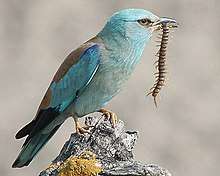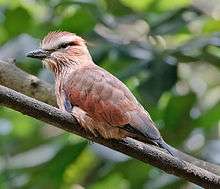Coracias
Coracias is a genus of the rollers, an Old World family of near passerine birds related to the kingfishers and bee-eaters. They share the colourful appearance of those groups, blues and browns predominating. The two outer front toes are connected, but not the inner one.
| Coracias | |
|---|---|
 | |
| Adult European roller | |
| Scientific classification | |
| Kingdom: | Animalia |
| Phylum: | Chordata |
| Class: | Aves |
| Order: | Coraciiformes |
| Family: | Coraciidae |
| Genus: | Coracias Linnaeus, 1758 |
| Species | |
|
9, see text | |
| Synonyms | |
| |
Taxonomy
The generic name Coracias was used by Carl Linneaus in 1758 for birds with knife-shaped beaks and cartilaginous tongues.[1]
The Ancient Greek word korakías (κορακίας),[2] derived from korax (κόραξ, ‘raven, crow’).[3] Aristotle described the coracias as a bird as big as a crow with a red beak,[4] which some believe to be the chough.[5]
Living species
Nine species are recognized:[6]
| Image | Common Name | Scientific name | Distribution |
|---|---|---|---|
 | Purple roller | Coracias naevius | sub-Saharan Africa |
_Photograph_by_Shantanu_Kuveskar.jpg) | Indian roller | Coracias benghalensis | Western Asia to Indian Subcontinent |
 | Indochinese roller | Coracias affinis | eastern India to southeast Asia |
 | Purple-winged roller | Coracias temminckii | Islands of Sulawesi, Bangka, Lembeh, Manterawu, Muna and Butung. |
 | Racket-tailed roller | Coracias spatulatus | southern Africa from Angola, south-eastern Democratic Republic of Congo and southern Tanzania to northern Botswana, Zimbabwe, Malawi and Mozambique |
| Lilac-breasted roller | Coracias caudatus | sub-Saharan Africa and the southern Arabian Peninsula | |
| Abyssinian roller | Coracias abyssinicus | tropical Africa in a belt south of the Sahara, known as the Sahel | |
_(16475688389).jpg) | European roller | Coracias garrulus | Middle East, Central Asia and Morocco. |
 | Blue-bellied roller | Coracias cyanogaster | Senegal to northeast Democratic Republic of the Congo |
Former species
Formerly, some authorities also considered the following species (or subspecies) as species within the genus Coracias:
- Olive-backed oriole (as Coracias Sagittata)[7]
- Eurasian golden oriole (as Coracias Oriolus)[8]
- Black-hooded oriole (as Coracias Xanthornus)[9]
- Broad-billed roller (as Coracias glaucurus)[10]
- Broad-billed roller (afer) (as Coracias afra)[11]
- Oriental dollarbird (as Coracias orientalis)[12]
- Australian roller (as Coracias pacifica)[13]
Behaviour and ecology
Coracias rollers are watch-and wait hunters. They sit in a tree or on a post before descending on their prey and carrying it back in the beak to a perch before dismembering it. A wide range of terrestrial invertebrates, and small vertebrates such as frogs, lizards rodents and young birds, are taken. Their prey includes items avoided by many other birds, such as hairy caterpillars, insects with warning colouration and snakes.[14] They often perch prominently whilst hunting, like giant shrikes.
References
- Linnaeus, C. (1758). "Coracias". Systema naturae per regna tria naturae: secundum classes, ordines, genera, species, cum characteribus, differentiis, synonymis, locis. 1 (Tenth reformed ed.). Holmiae: Laurentii Salvii. p. 107−108.
- André Jean François Marie Brochant de Villers; Alexandre Brongniart; Pierre Jean François Turpin (1818). Dictionnaire des sciences naturelles (in French). Levrault. p. 349.
- Craig, J. (1854). A New Universal, Technological, Etymological, and Pronouncing Dictionary of the English Language. p. 407.
- Camus, A.-G. (1783). Histoire des animaux d'Aristote (in French). Chez la veuve Desaint. p. 225.
- Greek Word Study Tool
- "Rollers, ground rollers & kingfishers « IOC World Bird List". www.worldbirdnames.org. Retrieved 2017-02-24.
- "Oriolus sagittatus - Avibase". avibase.bsc-eoc.org. Retrieved 2017-02-24.
- "Oriolus oriolus - Avibase". avibase.bsc-eoc.org. Retrieved 2017-02-25.
- "Oriolus xanthornus - Avibase". avibase.bsc-eoc.org. Retrieved 2017-03-01.
- "Eurystomus glaucurus - Avibase". avibase.bsc-eoc.org. Retrieved 2017-03-06.
- "Eurystomus glaucurus afer - Avibase". avibase.bsc-eoc.org. Retrieved 2017-03-06.
- "Eurystomus orientalis - Avibase". avibase.bsc-eoc.org. Retrieved 2017-03-06.
- "Eurystomus orientalis pacificus - Avibase". avibase.bsc-eoc.org. Retrieved 2017-03-06.
- Fry, C. H.; Fry, K. (30 June 2010). Kingfishers, Bee-eaters and Rollers. Bloomsbury Publishing. pp. 15–16. ISBN 978-1408134573. OCLC 25547477.
- Kingfishers, Bee-eaters and Rollers by Fry, Fry and Harris, ISBN 0-7136-8028-8
External links
- Roller videos on the Internet Bird Collection